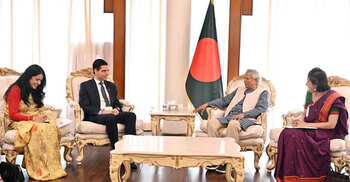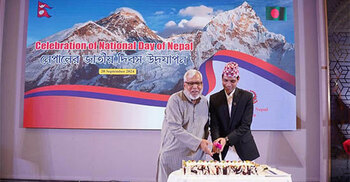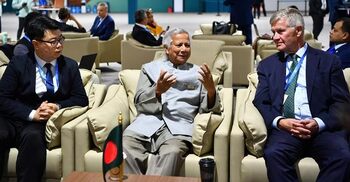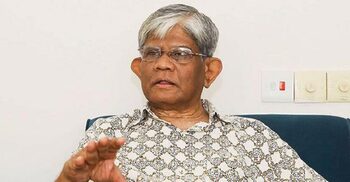Nepal starts exporting electricity to Bangladesh via India

A trilateral power-sharing agreement between Nepal, India, and Bangladesh came into effect on Friday as Nepal exported 40MW of electricity to energy-hungry Bangladesh, formally opening energy trade between the two countries.
This marks the start of electricity supply from Nepal to Bangladesh via an Indian grid.
Nepal and Bangladesh are not territorially linked. The two nations are separated by the ‘Siliguri Corridor’ —a 22-kilometre stretch in the Indian state of West Bengal that lies between southern Nepal and northern Bangladesh, reports The Kathmandu Post.
According to the Nepal Electricity Authority (NEA), the power utility, this is the first and last export to Bangladesh this year. As per the power agreement signed between Kathmandu and Dhaka on October 3, Nepal will export 40MW of electricity annually from June 15 to November 15, for five years.
The export began on Friday at noon and will end at midnight. This means supply will continue from mid-June next year.
Every year, Nepal is expected to sell 144,000 MWh (megawatt-hours) of electricity in five months at 6.4 US cents a unit.
Nepal’s Energy Minister Dipak Khadka, India’s Union Minister for Power and Housing and Urban Affairs Manohar Lal, and Bangladesh’s Fouzul Kabir Khan, adviser, Ministry of Power, Energy and Mineral Resources, jointly inaugurated the power flow from Nepal to Bangladesh through a virtual event hosted in Kathmandu.
“A Landmark feat in Regional Energy Cooperation!” Indian minister Lal wrote on social media platform X.
“Today, the first-ever power transaction from Nepal to Bangladesh via the Indian grid was virtually inaugurated. This historic initiative reflects India’s commitment to fostering regional energy integration and sustainable South Asian growth.”
“Today, Nepal begins exporting 40MW of electricity to Bangladesh, marking a historic milestone under the Tripartite Power Sales Agreement with NEA, BPDB, and NVVN. This green energy initiative promises industrial growth and regional prosperity,” Nepal’s energy minister Khadka wrote on X.
“We are happy that the export of electricity from Nepal to Bangladesh has started today. This is the first time in Nepal's history that electricity has been exported to another country after India. It is a historic milestone in regional electricity trade. After the Central Electricity Authority of India permitted the export of electricity from Nepal to Bangladesh, the export of electricity started on Friday,” Arzu Rana Deuba wrote on X.
“Special thanks to the Government of India for facilitating the export of electricity to Bangladesh and the Government of Bangladesh for importing electricity. Since our diplomatic efforts and initiatives continue to expand Nepal's electricity production and market potential, we also expect everyone's cooperation and coordination in the future.”

India announced its decision to facilitate the first trilateral power transaction from Nepal to Bangladesh through the Indian grid during the visit of the then prime minister Pushpa Kamal Dahal to India on May 31 last year.
During the visit, both sides reaffirmed their commitment to enhancing sub-regional cooperation, particularly in the energy sector. They emphasised that increased collaboration would strengthen inter-linkages between the economies, benefiting all stakeholders involved.
Subsequently, a tripartite power sales agreement between NTPC Vidyut Vyapar Nigam, NEA and Bangladesh Power Development Board was signed on October 3 in Kathmandu.
Nepal will transmit the energy to India through the 400KV Dhalkebar-Muzaffarpur cross-border transmission line before India transmits the equivalent to Bangladesh.
The NEA will calculate the quantum of exported energy at the Muzaffarpur point. The authority estimates that the country would earn around Rs330 million annually from the sales.
“The start of this power flow from Nepal to Bangladesh through India is expected to boost sub-regional connectivity in the power sector,” India’s Ministry of External Affairs said in a statement.
According to the Energy Scenario of Bangladesh (2022-23) published by the country’s Energy and Mineral Resources Division in February 2024, hydroelectricity accounts for just 1 percent of the country’s total generation of 24,911 MW. Renewable energy accounts for only 2 percent (459 MW) of this. This suggests the urgent need for renewable energy in Bangladesh.
Originally scheduled for July 28, the signing was postponed due to political unrest and a government change in Bangladesh.
Meanwhile, the chief advisor of Bangladesh, Prof Muhammad Yunus, met the Social Business Group on Wednesday in Baku, Azerbaijan, on the sidelines of the UN climate conference, COP29.
He called for the creation of a South Asian grid to share hydroelectricity generated by Nepal and Bhutan.
He said much of the hydroelectricity potential of the Himalayan nations remains untapped due to a lack of electricity grids connecting Bangladesh, India, Nepal, and Bhutan.
Nepal can generate 40,000 megawatts of hydroelectricity, which in turn can cut the reliance on fossil fuels in countries like India and Bangladesh.
Nepal plans to produce 28,500MW of hydroelectricity by 2035 and export it to India and Bangladesh to boost foreign currency earnings. Experts say trading electricity to India and Bangladesh would help Nepal reduce its ballooning trade deficit, which currently stands at Rs1.44 trillion. Nepal’s total foreign trade amounts to Rs1.74 trillion.
“Bangladesh can easily bring hydroelectricity from Nepal as it is only 40 miles from Bangladesh. Nepalese hydroelectricity will also be cheap,” Prof Yunus said.





